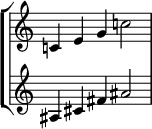Petrushka chord
| Component intervals from diminished fifth | |
|---|---|
| minor third | |
| diminished third | |
| root | |
| Forte no. | |
| 6-30 |
The Petrushka chord is a recurring polytonal device used in Igor Stravinsky's ballet Petrushka and in later music. These two major triads, C major and F♯ major – a tritone apart – clash, "horribly with each other", when sounded together and create a dissonant chord.[1]
Structure
The Petrushka chord in the piano during the second tableau of Petrushka[2] is shown below.

The Petrushka chord is defined as two simultaneous major triads separated by a tritone. In Petrushka, Stravinsky used C major on top of F♯ major (the latter presented here in first inversion):

The device uses tones that, together, make up a synthetic
The chords may be considered to contradict each other because of the tritone relationship: "Any tendency for a
At the end of the third tableau, the Petrushka chord appears with Petrushka but at A and E♭, which, with C and F♯, create a diminished seventh chord (0, 3, 6, 9) and exhaust the octatonic scale (9 1 4, 3 7 t, 0 4 7, and 6 t 1 = 0 1 3 4 6 7 9 t), "and suggests that it did... possess for Stravinsky an a priori conceptual status".[6]

Petrushka and origin
Although attributed to Stravinsky, the chord (or, more precisely, two simultaneous major chords set a tritone apart, specifically F and B major) was present much earlier in Franz Liszt's Malédiction Concerto.[7] (Although the exact date of the composition remains unknown, it is estimated by Humphrey Searle to be from about 1840; the composition is believed to have originated from one of Liszt's early works, performed in 1827.[8])
Stravinsky used the chord repeatedly throughout the ballet Petrushka to represent the puppet and devised the chord to represent the puppet's mocking of the crowd at the
Other uses
The 1979 song "Kogaion" by
The Petrushka chord is dominantly used in the track Above the Clouds, from the 2003
See also
References
- ISBN 0-7645-5009-8
- Taruskin, Richard(Spring, 1987). "Chez Pétrouchka – Harmony and Tonality "chez" Stravinsky", p. 269, 19th-Century Music, Vol. 10, No. 3, Special Issue: Resolutions I., pp. 265–286.
- ^ Busby, Paul. "Short Scales", Scored Changes: Tutorials.
- ISBN 0-7579-0357-6.
- ^
ISBN 0-19-311906-4.
- ^ Taruskin 1987, p.268.
- ISBN 0-19-509173-6
- ISBN 0-521-32627-3. Retrieved Jun 30, 2009.
- ^ Journal of the American Musicological Society 52 (1999), 531–592.
- ISBN 0-7611-0487-9.
- ^ Eric Walter White (1966). Stravinsky: The Composer and His Works, p. 161. quoted in Taruskin, Richard (Spring, 1985). "Chernomor to Kashchei: Harmonic Sorcery; Or, Stravinsky's 'Angle'", p.75, Journal of the American Musicological Society, Vol. 38, No. 1., pp. 72–142.
